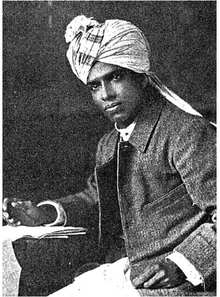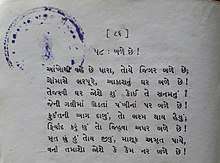Amrit Keshav Nayak
Amrit Keshav Nayak (14 April 1877 – 18 July 1907) was a Parsi theatre actor-director, lyricist and Gujarati author. He joined theatre at early age and later directed several plays including adaptations of plays of Shakespeare. He wrote plays and novels also.
Amrit Keshav Nayak | |
|---|---|
 Amrit Keshav Nayak | |
| Born | 14 April 1877 Ahmedabad, Gujarat |
| Died | 18 July 1907 (aged 30) Bombay |
| Pen name | Shivsambhu Sharmano Chiko |
| Occupation | actor, director, poet, writer |
| Language | Gujarati |
| Nationality | Indian |
| Notable works | M. A. Banake Kyon Meri Mitti Kharab Ki? (1908) |
| Spouse | Parvati |
| Partner | Gauhar Jaan |
| Children | Saroj |
Biography
Early life
Nayak was born in Ahmedabad on 14 April 1877 (Vaishakh Shukla 1 Vikram Samvat 1933) to Nayak family. He lived in Mata ni Pol in Kalupur area of the city. He studied only four grades and two grades in Urdu. Nayak moved to Bombay with his father.[1][2][3][4]
Theatre and lyricist career
In 1888, he joined Alfred Company at the age of eleven at the salary of forty rupees a month.[5][6] After his successful roles of Baheram Irani and Pumba in Bamanji Kabraji's Gamde ni Gori (Village Nymph, 1890) and Bimar-e-Bulbul respectively,[6][5] he went to Lucknow to study theatre under Bindadin Maharaj. He learned music there. After his return in 1891, he directed Allauddin and played Laila himself whose success elevated him to post of Assistant Manager at the age of 15. He pioneered the adaptation of plays of Shakespeare in Urdu. He directed Mehdi Hasan Ahsan's Khun-e-Nahaq (Unjustified Murder, 1898, based on Hamlet) and Bazum-e-Fani (Fatal Union, 1898, based on Romeo and Juliet) for Kavasji Palanji Khatau's Alfred Theatre Company. He directed several plays of Urdu dramatist Agha Hashar Kashmiri including his adaptation of Shakespeare's play, Murid-e-Shaque (Victim of Suspicion, 1899, based on A Winter's Tale) and Shahid-e-Naaz (Measure for Measure, 1904) . Following differences with Khatau in 1904, he left the Alfred Company joined Framji Apu's Parsi Natak Mandali as a director.[6][5] He produced Shakespeare's Cymbeline in Urdu as Meetha Zahar ('Sweet Poison').[6][1] He was married to Parvati, an illiterate girl from Kadi at an early age. They had a daughter named Saroj.[1][7] He had a brief relationship with singer and dancer Gauhar Jaan whom he met around 1904–05 in Bombay and together they wrote and composed several hit songs like Pardesi Saiyyan Nena Lagake Dukh De Gaye, Sar Par Gagar Dhar Kar, Dilenadaan Ko Hum Samjhate Jayenge, Aan Baan Jiya Mein Laagi. He was working on his new production Narayan Prasad Betab's Zahari Saanp before he died on 18 July 1907 (Ashadh Sukla 8 Vikram Samvat 1963) in Bombay following heart attack.[6][1][2][3][8][4]
Literary career

Nayak's pen-name was Shivsambhu Sharmano Chiko (Gujarati: શિવશંભુ શર્માનો ચિકો).[2]
Nayak wrote a column for Amrita Bazar Patrika and Gujarati periodicals. Chiththa Lekhanmala column in Gujarati has some influence on the Indian independence movement. He wrote a play, Bharat Durdasha Natak (1909) about prevalent condition of India. His novel M. A. Banake Kyon Meri Mitti Kharab Ki? (1908) was about shortcomings of education system. His another novel, Mariyam was about a Muslim life. His incomplete and unpublished works are Sanskrit ane Farsi Bhasha no Paraspar Sambandh (Relationship of Sanskrit and Persian languages) and Nadirshah. Apart from lyrics for songs for his plays, he wrote Gazals in Gujarati too.[6][1][2][3][9]
Legacy
The Amrit Keshav Nayak Road behind Khadi Bhandar in Fort area of Mumbai is named after Nayak.[6][10]
See also
References
- Sampath, Vikram. My Name is Gauhar Jaan. Rupa Publications. pp. 120–122. ISBN 978-81-291-2233-9.
- "Amrit Nayak" (in Gujarati). Gujarati Sahitya Parishad. Retrieved 17 October 2014.
- Vashi, Ashish (31 May 2010). "Bombays nightingale of 1900s had lover in city pol!". The Times of India. Archived from the original on 17 October 2014. Retrieved 17 October 2014.
- Baradi, Hasmukh (2004). "Nayak, Amrit Keshav". In Lal, Ananda (ed.). Oxford Companion to Indian Theatre. Oxford University Press. doi:10.1093/acref/9780195644463.001.0001. ISBN 9780195644463 – via Oxford Reference. (subscription required)
- Shastri, Dr. Gopal (1995). પારસી રંગભૂમિ [Parsi Theatre] (in Gujarati). Vadodara: Sadhna Shastri. pp. 71–72.
- Choksi, Mahesh; Somani, Dhirendra, eds. (2004). ગુજરાતી રંગભૂમિ: રિદ્ધિ અને રોનક (Gujarati Rangbhoomi: Riddhi Ane Ronak) [Compilation of Information regarding professional theatre of Gujarat]. Ahmedabad: Gujarat Vishwakosh Trust. p. 43. OCLC 55679037.
- Nayak, Ratilal S. (January 2003). અભિનય-સમ્રાટ અને સાક્ષર અમૃત કેશવ નાયક [Amrut Keshav Nayak - A Monograph of an allround actor & Director of Parsi-Urdu Professional Theatre] (in Gujarati) (1st ed.). Unjha: Asait Sahitya Sabha. pp. 11–12.
- Gautam, Savitha (13 May 2010). "Recording Gauhar Jaan - My Name is Gauhar Jaan - Vikram Sampath - Book Review". The Hindu. Retrieved 17 October 2014.
- Datta, Amaresh; various (1 January 2006). The Encyclopaedia Of Indian Literature (Volume Two) (Devraj To Jyoti). Sahitya Akademi. p. 1389. ISBN 978-81-260-1194-0.
- Nayak, Chinubhai (1998). Thaker, Dhirubhai (ed.). ગુજરાતી વિશ્વકોશ [Gujarati Encyclopedia] (in Gujarati). X (1st ed.). Ahmedabad: Gujarati Vishwakosh Trust. p. 92. OCLC 165832685.
Further reading
- Nayak, Ratilal S. (January 2003). અભિનય-સમ્રાટ અને સાક્ષર અમૃત કેશવ નાયક [Amrut Keshav Nayak - A Monograph of an allround actor & Director of Parsi-Urdu Professional Theatre] (in Gujarati) (1st ed.). Unjha: Asait Sahitya Sabha.